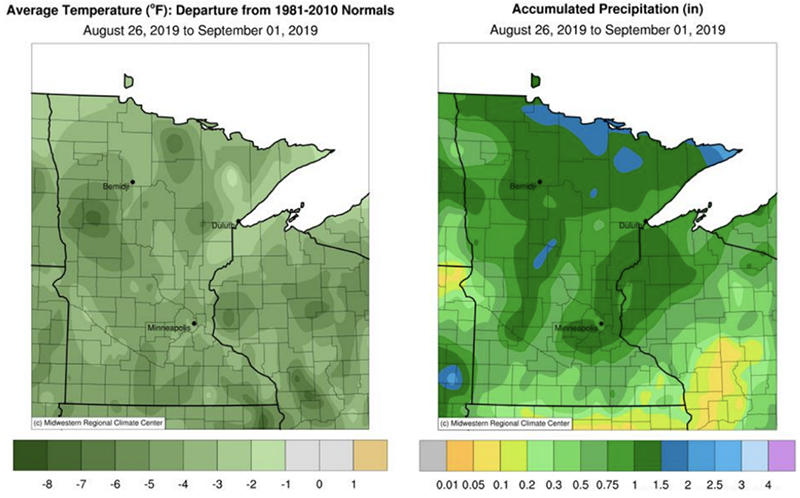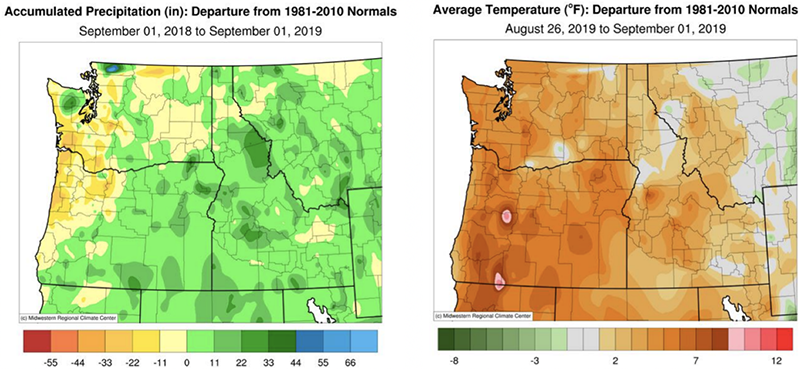September 4, 2019
For the week ending September 1st, the dry pea and lentil harvests continued to advance, and the dry bean harvest got underway.

The harvesting of pulse crops is behind the average pace in most of the top pulse-growing states in the U.S. Soil moisture levels are good in the northern Great Plains, but somewhat low in Michigan and the Pacific Northwest.
Michigan, an important black bean growing state, received some rain last week, but more moisture is needed. Topsoil moisture rated 55% adequate to surplus and subsoil moisture rated 53% adequate to surplus. The bean crop is still slightly behind the five-year average, with 97% of the plants blooming (the average is 98%), 81% setting pods (compared to the average of 89%) and 6% dropping leaves (versus the average of 17%). The crop rated 6% very poor, 15% poor, 22% fair, 41% good and 16% excellent.
Minnesota is a key kidney bean growing state. Last week, topsoil moisture rated 86% adequate to surplus. Subsoil moisture rated 91% adequate to surplus. The dry bean harvest is underway, with 2% of the crop harvested. Forty-eight percent of the bean plants are dropping leaves, three days ahead of the average pace.

Montana is a major producer of pulse crops. Last week, topsoil moisture rated 72% adequate to surplus. Subsoil moisture rated 73% adequate to surplus. Stormy weather across much of the state slowed the harvest of pulse crops. By the end of the week, dry bean harvest progress stood at 21%, behind the average pace of 57%. Dry pea harvest progress stood at 74%, behind the average pace of 89%. The lentil harvest advanced to 55% complete. The lentil crop rated 4% very poor to poor, 28% fair, 62% good and 6% excellent.
North Dakota is the country’s top dry bean producing state. Topsoil moisture rated 88% adequate to surplus. Subsoil moisture rated 81% adequate to surplus. The dry pea harvest advanced to 84% complete. Lentil harvest progress stood at 23%. One percent of the dry bean crop was harvested, behind the average pace of 14%. Sixty three percent of the bean plantings were dropping leaves, behind the average of 67%. The crop rated 3% very poor, 10% poor, 29% fair, 51% good and 7% excellent.
The Pacific Northwest is an important pulse producing region. In Idaho, top- and subsoil moisture levels were 55 and 51% very short to short. In Oregon, they were 73 and 71% very short to short. Soil moisture levels were somewhat better in Washington, where topsoil moisture was 50% very short to short and subsoil moisture was 39% very short to short. In Idaho, dry bean harvest progress was at 22%, behind the average pace of 32%, and pea harvest progress was at 87%, behind the average pace of 92%. The bean crop rated 1% poor, 51% fair, 45% good and 3% excellent. In Oregon, bean harvest progress was at 29%, and the crop rated 8% very poor to poor, 28% fair, 52% good and 12% excellent. In Washington, the dry pea harvest advanced to 78%, behind the average pace of 92%. The bean crop, meanwhile, rated 7% poor, 39% fair, 47% good and 7% excellent.

Disclaimer: The opinions or views expressed in this publication are those of the authors or quoted persons. They do not purport to reflect the opinions or views of the Global Pulse Confederation or its members.